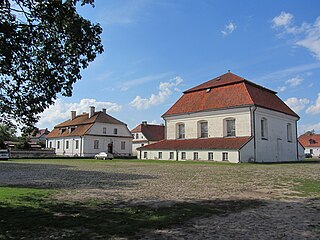
The Final Solution or the Final Solution to the Jewish Question was a Nazi plan for the genocide of Jews during World War II. The "Final Solution of the Jewish Question" was the official code name for the murder of all Jews within reach, which was not restricted to the European continent. This policy of deliberate and systematic genocide starting across German-occupied Europe was formulated in procedural and geopolitical terms by Nazi leadership in January 1942 at the Wannsee Conference held near Berlin, and culminated in the Holocaust, which saw the killing of 90% of Polish Jews, and two thirds of the Jewish population of Europe.
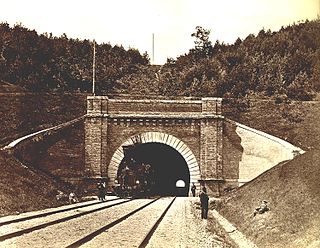
Paneriai is a neighborhood of Vilnius, situated about 10 kilometres away from the city center. It is the largest elderate in the Vilnius city municipality. It is located on low forested hills, on the Vilnius-Warsaw road. Paneriai was the site of the Ponary massacre, a mass killing of as many as 100,000 people from Vilnius and nearby towns and villages during World War II.

Lithuanian Jews or Litvaks are Jews with roots in the present-day Lithuania, Belarus, Latvia, northeastern Suwałki and Białystok region of Poland and some border areas of Russia and Ukraine. The term is sometimes used to cover all Orthodox Jews who follow a "Lithuanian" style of life and learning, whatever their ethnic background. The area where Lithuanian Jews lived is referred to in Yiddish as ליטע Lite, hence the Hebrew term Lita'im (לִיטָאִים).
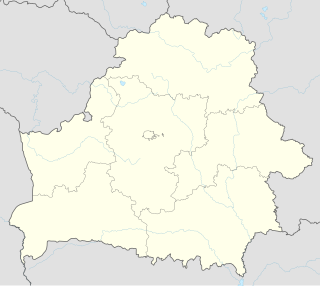
Braslaw or Braslaŭ is a town in the Vitebsk Region of Belarus, an administrative center of the Braslaw District.

The history of the Jews during World War II is almost synonymous with the Jewish persecution and murder of unprecedented scale in modern times in political Europe inclusive of European North Africa. The massive scale of the Holocaust which happened during World War II heavily affected the Jewish nation and world public opinion, which only understood the dimensions of the Final Solution after the war. The genocide, known as HaShoah in Hebrew, aimed at the elimination of the Jewish people on the European continent. It was a broadly organized operation led by Nazi Germany, in which approximately six million Jews were murdered methodically and with horrifying cruelty. During the Holocaust in occupied Poland, more than one million Jews were murdered in gas chambers of the Auschwitz concentration camp alone. The murder of the Jews of Europe affected Jewish communities in Albania, Austria, Belarus, Belgium, Bosnia & Herzegovina, Channel Islands, Croatia, Czech Republic, Estonia, France, Germany, Greece, Hungary, Italy, Latvia, Libya, Lithuania, Luxembourg, Macedonia, Moldova, The Netherlands, Norway, Poland, Romania, Russia, Serbia, Slovakia, and Ukraine.

Goniądz is a town in Poland, located at the Biebrza river, in Mońki county in Podlaskie Voivodeship in northeastern Poland. 80% of the town was destroyed in World War II. Rebuilt, in modern times the town is a local centre of agriculture, as well as a tourist destination.
The Lithuanian Security Police (LSP), also known as Saugumas, was a local police force that operated in German-occupied Lithuania from 1941 to 1944, in collaboration with the occupational authorities. Collaborating with the Nazi Sipo and SD, the unit was directly subordinate to the German Kripo. The LSP took part in perpetrating the Holocaust in Lithuania, persecuting Polish resistance and communist underground.

During World War II, Lithuania was occupied by the Soviet Union (1940–1941), Nazi Germany (1941–1944), and the Soviet Union again in 1944. Resistance during this period took many forms. Significant parts of the resistance were formed by Polish and Soviet forces, some of which fought with Lithuanian collaborators. This article presents a summary of the organizations, persons and actions involved.
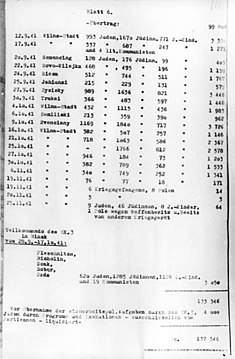
The so-called Jäger Report, also Jaeger Report was written on 1 December 1941 by Karl Jäger, commander of Einsatzkommando 3, a killing unit of Einsatzgruppe A which was attached to Army Group North during the Operation Barbarossa. It is the most detailed and precise surviving chronicle of the activities of one individual Einsatzkommando, and a key record documenting the Holocaust in Lithuania as well as in Latvia and Belarus.

The Ponary massacre or Paneriai massacre was the mass murder of up to 100,000 people by German SD and SS and their Lithuanian collaborators, including Ypatingasis būrys killing squads, during World War II and the Holocaust in Reichskommissariat Ostland. The murders took place between July 1941 and August 1944 near the railway station at Ponary, a suburb of today's Vilnius, Lithuania. Some 70,000 Jews were murdered at Ponary, along with up to 20,000 Poles, and 8,000 Russian POWs, most of them from nearby Vilna (Vilnius), and its newly-formed Vilna Ghetto.
The Lithuanian TDA Battalions or TDA, were paramilitary units organized in June–August 1941 by the Provisional Government of Lithuania at the onset of Operation Barbarossa. Members of the TDA were known by many names such as Lithuanian auxiliaries, policemen, white-armbands, nationalists, rebels, partisans, or resistance fighters. TDA was intended as basis for the future independent Lithuanian Army, but soon it was taken over by Nazi officials and reorganized into the Lithuanian Auxiliary Police Battalions. The original TDA eventually became the 12th and the 13th Police Battalions. These two units took an active role in mass killings of the Jews in Lithuania and Belarus. Based on the Jäger Report, members of TDA murdered about 26,000 Jews between July and December 1941.
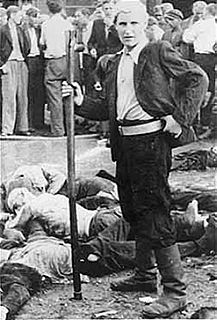
The Kaunas pogrom was a massacre of Jewish people living in Kaunas, Lithuania that took place on June 25–29, 1941 – the first days of the Operation Barbarossa and of Nazi occupation of Lithuania. The most infamous incident occurred in the Lietūkis garage, where several dozen Jewish men were publicly tortured and executed on June 27, most of them killed by a single club-wielding assailant nicknamed the "Death Dealer." After June, systematic executions took place at various forts of the Kaunas Fortress, especially the Seventh and Ninth Fort.

Kapčiamiestis is a town in Lithuania located near the confluence of Baltoji Ančia and Nieda Rivers.
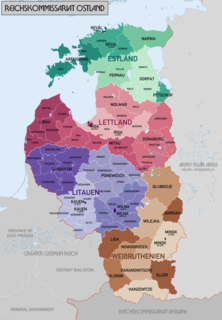
The Holocaust in German occupied Lithuania resulted in the near total destruction of Lithuanian (Litvaks) and Polish Jews, living in Generalbezirk Litauen of Reichskommissariat Ostland within the Nazi-controlled Lithuanian SSR. Out of approximately 208,000–210,000 Jews, an estimated 190,000–195,000 were murdered before the end of World War II, most between June and December 1941. More than 95% of Lithuania's Jewish population was massacred over the three-year German occupation — a more complete destruction than befell any other country affected by the Holocaust. Historians attribute this to the massive collaboration in the genocide by the non-Jewish local paramilitaries, though the reasons for this collaboration are still debated. The Holocaust resulted in the largest-ever loss of life in so short a period of time in the history of Lithuania.

The occupation of Lithuania by Nazi Germany lasted from the German invasion of the Soviet Union on June 22, 1941 to the end of the Battle of Memel on January 28, 1945. At first the Germans were welcomed as liberators from the repressive Soviet regime which occupied Lithuania prior to the German arrival. In hopes of re-establishing independence or regaining some autonomy, Lithuanians organized their Provisional Government. Soon the Lithuanian attitudes towards the Germans changed into passive resistance.
RollkommandoHamann was a small mobile unit that committed mass murders of Lithuanian Jews in the countryside in July–October 1941, with a death toll of at least 60,000 Jews. The unit was also responsible for a large number of murders in Latvia from July through August, 1941. At the end of 1941 the destruction of Lithuanian Jewry was effectively accomplished by the Rollkommando in the countryside, by the Ypatingasis būrys in the Ponary massacre, and by the Tautinio Darbo Apsaugos Batalionas in the Ninth Fort in Kaunas. In about six months an estimated 80% of all Lithuanian Jews were killed. The remaining few were spared for use as a labor force and concentrated in urban ghettos, mainly the Vilna and Kaunas Ghettos.

Rozalimas is a small town in Šiauliai County in northern-central Lithuania. As of 2011 it had a population of 746.

Joniškis is a small town in Utena County, Lithuania. According to the 2011 census, the town has a population of 258 people.

The Šiauliai or Shavli Ghetto was a Jewish ghetto established in July 1941 by Nazi Germany in the city of Šiauliai in Nazi-occupied Lithuania during the Holocaust. The ghetto comprised two areas – one in the Kaukazas suburb and one on Trakai Street. Both were liquidated by July 1944, and their inhabitants were killed or transferred to Nazi concentration camps. In 1939, one quarter of the population of Šiauliai was Jewish, about 8,000 persons. By the end of World War II, only about 500 Jews of the city had survived.

The Plungė massacre was a World War II massacre committed on 13 or 15 July 1941 in the town of Plungė, in Lithuania. Following the June Uprising in Lithuania and the German invasion as part of Operation Barbarossa, Plungė was captured by German forces on 25 June 1941. Lithuanian nationalists, led by Jonas Noreika, formed a town administration and police force. German forces killed 60 young Jewish men, accused by the Lithuanians of being a read guard for the Red Army, shortly after the town's capture. On 26 June 1941, the Lithuanians forced the Jews into a ghetto, and forced the Jews to perform heavy labor. On 13 or 15 July the Lithuanian nationalists transported the Jews to ditches near the village of Kausenai where they were shot. Of the 1,700-1,800 remaining Jews of Plungė, only a few survived.




